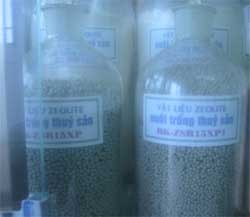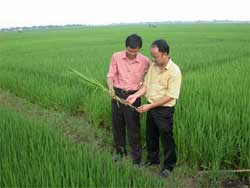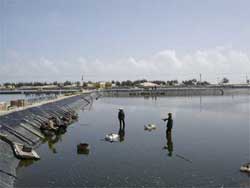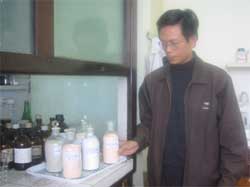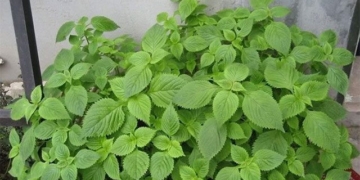With groundbreaking technology, experts from Hanoi University of Science and Technology have transformed natural clay minerals in Vietnam into high-value zeolite materials for agriculture, livestock, chemical industry, and environmental protection.
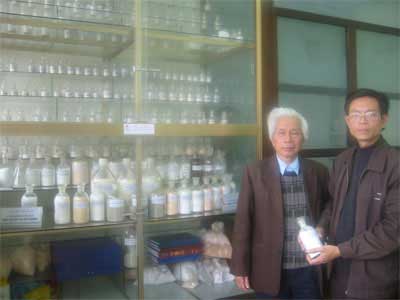 |
Prof. Dr. Hoàng Trọng Yêm (left) and Dr. Tạ Ngọc Đôn in front of a display cabinet of zeolite products produced using the technology of Hanoi University of Science and Technology. |
Recently, two zeolite production plants in Quảng Bình and Cần Thơ have been constructed and are now operational with a capacity of 3,000 tons per year, under the technology transfer model from Hanoi University of Science and Technology to the localities. These are the first industrial-scale zeolite production plants in Vietnam, aimed at aquaculture.
Success from a Spirit of Innovation and Action
According to Dr. Tạ Ngọc Đôn, the project leader and Deputy Head of the Chemical Technology Department, zeolite is a porous material, available in powder or granule form, that settles at the bottom of ponds and lakes. There, it serves to adsorb metal ions, ammonium, hydrogen sulfide (H2S), nitrogen dioxide (NO2), nitric oxide (NO), and harmful organic substances, thereby purifying the aquaculture environment. When dredging ponds and lakes, zeolite laden with toxins can be recycled into fertilizers for future use.
The zeolite mentioned is produced from clay types readily available in Vietnam. The primary raw material is kaolin, a clay mineral found in many localities with large reserves that can be mined and utilized for hundreds of years. Other clay minerals can also be used as additives in zeolite production.
Prof. Dr. Hoàng Trọng Yêm is the visionary who first proposed transforming Vietnam’s natural clay minerals into high-value materials. He noted that this zeolite production technology is not only new to Vietnam but also to the world. No country has yet transformed unbaked kaolin into zeolite. However, with a mindset of innovation, overcoming skepticism from experts and accepting risks, the research team pursued this direction. Their motto is that if they strive to search, they will discover what the world has not yet researched.
After completely failing with 500 experimental samples, the research team successfully produced zeolite on September 30, 1999, more than a year after starting the project. The structure of unbaked kaolin was disrupted using chemicals and then rearranged into zeolite. Simplifying it, Dr. Đôn likens the raw kaolin to a block of tightly interconnected bricks. The secret is to separate these bricks and rearrange them into a structure with voids.
This innovation in low-cost zeolite production meets a significant demand currently in Vietnam. In contrast, the traditional method of firing kaolin does not fully disrupt the material’s structure, resulting in lower efficiency.
In Vietnam, there are already some units researching and producing this material from clean chemicals. However, it is difficult to apply on a large scale due to high costs. Conversely, using clay to make zeolite means that the domestic product cost is only one-tenth that of zeolite made from clean chemicals and about half the price of natural zeolite. It is reported that the price of imported natural zeolite from Thailand and Indonesia for aquaculture is 4,000-4,200 VND/kg, while the price of synthetic zeolite from natural clay using Hanoi University of Science and Technology’s technology is less than half of that.
Broad Application Potential
 |
Zeolite material used for environmental protection. |
Dr. Đôn stated that the use of zeolite in aquaculture is just one of six application directions that the research team is pursuing. Leveraging its adsorptive properties, the team has created fertilizer types containing zeolite. Zeolite will gradually release nutrients from the fertilizer into the soil, helping to reduce fertilizer usage, increase soil fertility (due to its porous nature), retain moisture, and regulate soil pH (in Vietnam, the soil tends to be slightly acidic while zeolite is alkaline).
The zeolite-containing fertilizer was applied during the summer-autumn rice crop in 2005 on 3,000 m² across three districts in Thanh Hoá province. Results showed that this fertilizer helped earn an additional 300,000-600,000 VND/ha compared to the control. The team has refined the technology and is collaborating on a project to build the first NPK fertilizer plant containing zeolite in Vietnam, with a capacity of 15,000 tons per year.
In the livestock sector, the team is working to trial zeolite-based additives for pig and chicken feed. When mixed into feed, the formulation will adsorb toxins within the animals, enhance disease resistance, stimulate digestion, and promote growth. It is known that zeolite is non-toxic to both humans and livestock.
Zeolite is also used to separate heavy metal ions, ammonium, and harmful organic compounds in wastewater and domestic water. The product has been tested for cleaning Hồ Văn water and yielded positive results. Additionally, it is a material used in the production of absolute alcohol (due to zeolite’s selective water separation properties), petrochemical filtration (due to its adsorption and catalytic properties), pharmaceuticals, and pesticides.
Despite having four patents and useful solutions granted, the research team has not stopped there. Their plan is to create larger-sized porous materials to absorb colorants in dye wastewater and large molecular organic compounds. Currently, the particles range from 1,000 to 5,000 nm, but the team aims to reduce the particle size to below 100 nm to create nano-zeolite materials to enhance the application potential of this material in the future.
|
|
|
|










































